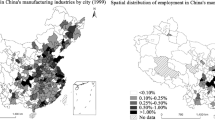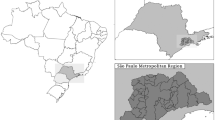Abstract
The proposition that ties between home offices and branch plants constitute a form of metropolitan dominance is evaluated by examining the dependence of these two forms of manufacturing organization on selected characteristics of the 110 largest SMSAs. The predictor variables in the analysis are measures of industry composition, population size, and regional location, factors which past research has shown to be indicators of rank in an urban hierarchy of dominance. The data generally support the hypothesis in revealing that headquarters locate in large, diversified urban areas, whereas branch plant employment is highest in small, economically specialized places. Both headquarters and branch plant activity proved to be associated with the percent of the SMSA labor force employed in manufacturing, however. The suggestion drawn from earlier studies, that specialization in metropolitan financial-commercial functions should be related to the headquarters’ presence, receives only mixed and ambiguous support in this investigation.
Similar content being viewed by others
References
Abrahamson, M.. and M. A. DuBick: 1977. Patterns of Urban Dominance: The U.S. in 1890. American Sociological Review 42:756–768.
Berry, Brian J. L.. and E. Neils. 1969. Location, Size. and Shape of Cities as Influenced by Environmental Factors. Pp. 257–302 in Harvey S. Perloff (ed.), The Quality of the Urban Environment. Baltimore: Johns Hopkins University Press.
—, and A. Pred (eds.). 1961. Central Place Studies: A Bibliography of Theory and Applications. Philadelphia: Regional Science Institute.
Bogue. Donald J. 1949. The Structure of the Metropolitan Community. Ann Arbor: Horace H. Rackham School of Graduate Studies, University of Michigan.
Carroll, R. L. 1963. The Metropolitan Influence of the 168 Standard Metropolitan Area Central Cities. Social Forces 42:166–173.
Duncan, Beverly, and S. Lieberson. 1970. Metropolis and Region in Transition. Beverly Hills: Sage Publications.
Duncan, Otis D., W. R. Scott, S. Lieberson, B. Duncan, and H. H. Winsborough. 1960. Metropolis and Region. Baltimore: Johns Hopkins University Press.
Editors of Fortune. 1963. Plant and Product Directory, 1963–64. Vol. I. New York: Time.
Freeman, J. H., and J. E. Kronenfeld. 1973. Problems of Definitional Dependency: The Case of Administrative Intensity. Social Forces 52:108–121.
Fuguitt, G. V., and S. Lieberson. 1974. Correlations or Ratios or Difference Scores Having Common Terms. Pp. 128–144 in Herbert L. Costner (ed.), Sociological Methodology, 1973-74. San Francisco: Jossey-Bass Publishers.
Gibbs, J. P., and D. L. Poston, Jr. 1975. The Division of Labor: Conceptualization and Related Measures. Social Forces 53:468–475.
Gras, N. S. B. 1922. The Development of Metropolitan Economy in Europe and America. American Historical Review 27:695–708.
Hawley, Amos H. 1971. Urban Society: An Ecological Approach. New York: Ronald Press.
Hoover, Edgar M., and R. Vernon. 1959. Anatomy or a Metropolis. Cambridge, Mass.: Harvard University Press.
Lieberson, S. 1969. Measuring Population Diversity. American Sociological Review 34:850–862.
—. and I. L. Allen, Jr. 1963. Location of National Headquarters or Voluntary Associations. Administrative Science Quarterly 8:317–338.
McKenzie, Roderick D. 1933. The Metropolitan Community. New York: McGraw-Hili Book Company.
Pappenfort, D. M. 1959. The Ecological Field and the Metropolitan Community: Manufacturing and Management. American Journal or Sociology 64:380–385.
Schnore, L. F. 1957. Satellites and Suburbs. Social Forces 36:121–139.
Semple, R. K. 1973. Recent Trends in the Spatial Concentration of Corporate Headquarters. Economic Geography 49:309–318.
Taylor, Graham R. 1915. Satellite Cities: A Study or Industrial Suburbs. New York: D. Appleton and Company.
U.S. Bureau or the Census. 1967. County Business Patterns, 1967. Washington, D.C.: U.S. Government Printing Office.
Vance, R. B., and S. S. Sutker. 1954. Metropolitan Dominance and Integration. Pp. 113–134 in Rupert B. Vance and N. J. Demerath (eds.), The Urban South. Chapel Hill: University or North Carolina Press.
Vernon, Raymond. 1960. Metropolis, 1985. Cambridge, Mass.: Harvard University Press.
Author information
Authors and Affiliations
Rights and permissions
About this article
Cite this article
Lincoln, J.R. The urban distribution of headquarters and branch plants in manufacturing: Mechanisms of metropolitan dominance. Demography 15, 213–222 (1978). https://doi.org/10.2307/2060524
Issue Date:
DOI: https://doi.org/10.2307/2060524




